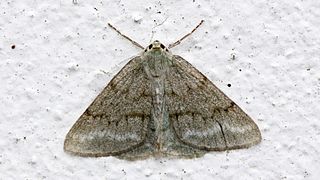
Aristoxenus of Tarentum was a Greek Peripatetic philosopher, and a pupil of Aristotle. Most of his writings, which dealt with philosophy, ethics and music, have been lost, but one musical treatise, Elements of Harmony, survives incomplete, as well as some fragments concerning rhythm and meter. The Elements is the chief source of our knowledge of ancient Greek music.

Biston is a genus of large, long-winged moths belonging to the family Geometridae. It is most notable for containing the well-known peppered moth. The genus was first described by William Elford Leach in 1815.

Martins's tamarin or Martin's ochraceous bare-face tamarin, is a species of tamarin endemic to Brazil.

Roger Russell Wehrli is an American former football player who was a cornerback for his entire 14-year career with the St. Louis Cardinals of the National Football League (NFL) from 1969 until 1982. He was a seven-time Pro Bowler after playing college football at the University of Missouri, where he was a consensus All-American and a first-round draft choice by the Cardinals in 1969. He was inducted to the College Football Hall of Fame in 2003 and the Pro Football Hall of Fame in 2007.

The Bistonini are a tribe of geometer moths in subfamily Ennominae. As numerous ennomine genera have not yet been assigned to a tribe, the genus list is preliminary. In addition, the entire tribe is sometimes merged into a much-expanded Boarmiini. In other treatments, the Erannini are included in the present group.

Ophthalmitis is a genus of geometer moths in the Boarmiini tribe.

Abraxas, the magpie moths, is a genus of moths in the family Geometridae. It was first described by William Elford Leach in 1815.

Charissa is a genus of moths in the family Geometridae.

Gnophos is a genus in the geometer moth family (Geometridae). A mostly Old World lineage, it is abundant in the Palearctic, with some North American species as well; in Europe six species are recorded. This genus has about 120 known species altogether in several recognized subgenera, with new ones still being discovered occasionally.

Lomographa is a genus of moths in the family Geometridae. The genus was erected by Jacob Hübner in 1825.

Naxidia is a genus of moths in the family Geometridae.

Obeidia is a genus of moths in the family Geometridae erected by Francis Walker in 1862.

Pseudoterpna is a genus of moths in the family Geometridae first described by Jacob Hübner in 1823.

Glacies coracina, the black mountain moth, is a moth of the family Geometridae. The species was first described by Eugenius Johann Christoph Esper in 1805. It is found in northern Europe and in mountainous areas from Norway, Sweden, Finland, Poland and northern Russia to Japan. It is also present in Great Britain, Romania and Bulgaria and in the Alps. It is found at elevations of up to 3,000 meters.

Pseudoterpna coronillaria, the Jersey emerald or gorse emerald, is a moth of the family Geometridae. The species was first described by Jacob Hübner in 1796. It is known from Spain, Portugal, the Pyrenees, western and southern France, Corsica, Sardinia, Sicily, Italy, Samos, Rhodes, Turkey, Israel, Lebanon, northern Jordan and North Africa. It has not been reported from mainland Great Britain, but is present on Jersey, where it was previously overlooked as a form of the grass emerald, until 2001 when it was correctly identified.
Aspergillus ochraceus is a mold species in the genus Aspergillus known to produce the toxin ochratoxin A, one of the most abundant food-contaminating mycotoxins, and citrinin. It also produces the dihydroisocoumarin mellein. It is a filamentous fungus in nature and has characteristic biseriate conidiophores. Traditionally a soil fungus, has now began to adapt to varied ecological niches, like agricultural commodities, farmed animal and marine species. In humans and animals the consumption of this fungus produces chronic neurotoxic, immunosuppressive, genotoxic, carcinogenic and teratogenic effects. Its airborne spores are one of the potential causes of asthma in children and lung diseases in humans. The pig and chicken populations in the farms are the most affected by this fungus and its mycotoxins. Certain fungicides like mancozeb, copper oxychloride, and sulfur have inhibitory effects on the growth of this fungus and its mycotoxin producing capacities.

Scopula submutata, the Mediterranean lace border, is a moth of the family Geometridae. It is found in southern Europe, North Africa and the Near East. The habitat consists of open, dry grassland and rocky slopes.
Dindicodes costiflavens is a moth of the family Geometridae first described by Wehrli in 1933. It is found in western China.
Dindicodes ectoxantha is a moth of the family Geometridae first described by Wehrli in 1933. It is found in Yunnan, China.
Gnophini is a tribe of moths.
















